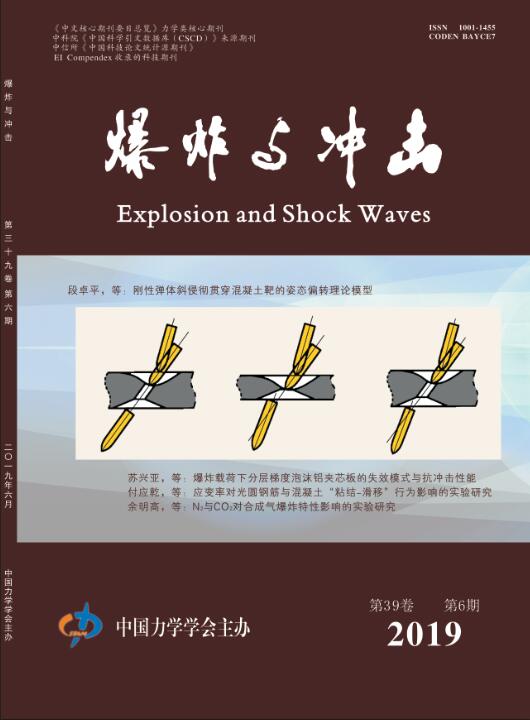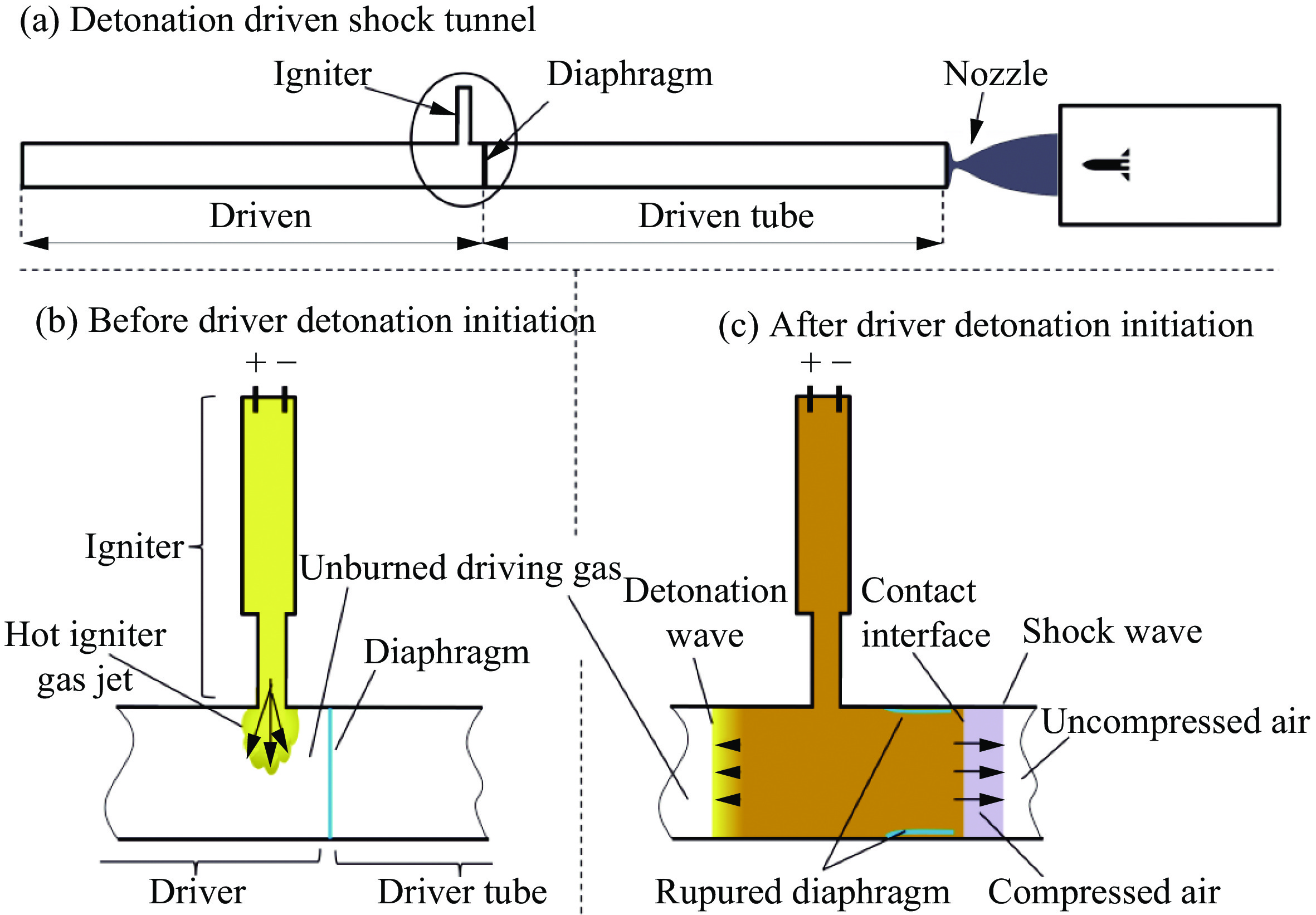| [1] |
俞鸿儒, 赵伟, 袁生学. 氢氧爆轰驱动激波风洞的性能 [J]. 气动实验与测量控制, 1993, 7(3): 38–42.
YU Hongru, ZHAO Wei, YUAN Shengxue. Performance of shock tunnel with H2-O2 detonation driver [J]. Aerodynamic Experiment and Measurement & Control, 1993, 7(3): 38–42.
|
| [2] |
OLIVIER H, JIANG Z, YU H R, et al. Detonation-driven shock tubes and tunnels [J]. Progress in Astronautics and Aeronautics, 2002, 198: 135–203.
|
| [3] |
JIANG Zonglin, LI Jinping, ZHAO Wei, et al. Investigating into techniques for extending the test-duration of detonation-driven shock tunnels [J]. Chinese Journal of Theoretical and Applied Mechanics, 2012, 44(5): 824–831. DOI: 10.6052/0459-1879-12-160. |
| [4] |
俞鸿儒. 大幅度延长激波风洞试验时间 [J]. 中国科学: 物理学·力学·天文学, 2015, 45(9): 094701.
YU Hongru. A big increase in shock tunnel test times [J]. Science China: Physics, Mechanics and Astronomy, 2015, 45(9): 094701.
|
| [5] |
MATSUI H. Characteristics of hydrogen explosions [J]. Journal of Safety Science and Technology, 2005, 1(6): 3–7.
|
| [6] |
INADA M, LEE J H, KNYSTAUTAS R. Photographic study of the direct initiation of detonation by a turbulent jet [J]. Progress in Astronautics and Aeronautics, 1993, 153: 253–253.
|
| [7] |
SHCHELKIN K L. Some methods for control of detonation [J]. Soviet Journal of Technical Physics, 1940, 10: 823–827.
|
| [8] |
SCHAUER F, STUTRUD J, BRADLEY R. Detonation initiation studies and performance results for pulsed detonation engine applications [C] // 39th Aerospace Sciences Meeting and Exhibit. 2001: 1129.
|
| [9] |
GRONIG H, OLIVIER H, HABERMANN M. Development of a detonation driver for a shock tunnel [J]. Review of High Pressure Science and Technology, 1998, 7: 879–884. doi: 10.4131/jshpreview.7.879 |
| [10] |
LEE S Y, CONRAD C, WATTS J, et al. Deflagration to detonation transition study using simultaneous Schlieren and OH PLIF images [C] // 36th AIAA/ASME/SAE/ASEE Joint Propulsion Conference and Exhibit. 2000: 3217.
|
| [11] |
LINDSTEDT R P, MICHELS H J. Deflagration to detonation transitions and strong deflagrations in alkane and alkene air mixtures [J]. Combustion and Flame, 1989, 76(2): 169–181. doi: 10.1016/0010-2180(89)90065-5 |
| [12] |
SANTORO R J, CONRAD C, LEE S Y, et al. Fundamental multi-cycle studies of the performance of pulse detonation engines [C] // Proceedings of the ISABE 2001 Conference. 2001.
|
| [13] |
COOPER M, JACKSON S, AUSTIN J, et al. Direct experimental impulse measurements for detonations and deflagrations [J]. Journal of Propulsion and Power, 2002, 18(5): 1033–1041. doi: 10.2514/2.6052 |
| [14] |
AKBAR R, THIBAULT P, HARRIS P, et al. Detonation properties of unsensitized and sensitized JP-10 and Jet-A fuels in air for pulse detonation engines [C] // 36th AIAA/ASME/SAE/ASEE Joint Propulsion Conference and Exhibit. 2000: 3592.
|
| [15] |
LI C, KAILASANATH K. Detonation initiation in pulse detonation engines [C] // 41st Aerospace Sciences Meeting and Exhibit. 2003: 1170.
|
| [16] |
张欣玉, 俞鸿儒, 赵伟, 等. 氢氧爆轰直接起始的射流点火方法研究 [J]. 气动实验与测量控制, 1996, 10(2): 63–68.
ZHANG Xinyu, YU Hongru, ZHAO Wei, et al. Turbulent jet initiation of oxy-hydrogen direct detonation [J]. Aerodynamic Experiment and Measurement & Control, 1996, 10(2): 63–68.
|
| [17] |
林伟, 周进, 林志勇, 等. 热射流起爆过程的试验研究 [C] // 第四届高超声速科技学术会议会议日程及摘要集. 北京, 2011: 12.
|
| [18] |
林伟. 爆震燃烧热射流起爆机理研究 [D]. 长沙: 国防科学技术大学, 2010.
|
| [19] |
LEE J H S, HIGGINS A J. Comments on criteria for direct initiation of detonation [J]. Philosophical Transactions of the Royal Society of London A: Mathematical, Physical and Engineering Sciences, 1999, 357(1764): 3503–3521. doi: 10.1098/rsta.1999.0506 |
| [20] |
KNYSTAUTAS R, LEE J H, MOEN I, et al. Direct initiation of spherical detonation by a hot turbulent gas jet [C] // Symposium (International) on Combustion. Elsevier, 1979, 17(1): 1235−1245.
|
| [21] |
BEZMELNITSIN A V, DOROFEEV S B, YANKIN Y G. Direct comparison of detonation initiation by turbulent jet under confined and unconfined conditions [R]. Moscow, Russia: Russian Research Centre Kurchatov Institute, 1997.
|
| [22] |
MEDVEDEV S P, KHOMIK S V, OLIVIER H, et al. Jet-initiated hydrogen detonation phenomena [M] // Shock Waves. Berlin, Heidelberg: Springer, 2005: 807−812.
|
| [23] |
THOMAS G. Some observations on the initiation and onset of detonation [J]. Philosophical Transactions of the Royal Society A: Mathematical, Physical and Engineering Sciences, 2012, 370(1960): 715–739. DOI: 10.1098/rsta.2011.0368. |
| [24] |
DOROFEEV S B, BEZMELNITSIN A V, SIDOROV V P, et al. Turbulent jet initiation of detonation in hydrogen-air mixtures [J]. Shock Waves, 1996, 6(2): 73–78. DOI: 10.1007/bf02515190. |
| [25] |
CARNASCIALI F, LEE J H S, KNYSTAUTAS R, et al. Turbulent jet initiation of detonation [J]. Combustion and Flame, 1991, 84(1/2): 170–180. DOI: 10.1016/0010-2180(91)90046-e. |
| [26] |
LIEBERMAN D, PARKIN K, SHEPHERD J. Detonation initiation by a hot turbulent jet for use in pulse detonation engines [C] // 38th AIAA/ASME/SAE/ASEE Joint Propulsion Conference and Exhibit. 2002: 3909.
|
| [27] |
LEWIS B, von ELBE G. Combustion, flames and explosions of gases [M]. Amsterdam: Elsevier North-Holland Press, 2012.
|










 DownLoad:
DownLoad:






